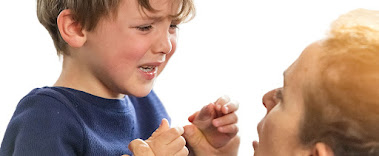The publication of the fifth edition of Diagnostic and Statistical Manual of Mental Disorders (DSM-5) will have a huge impact on Autism Spectrum Disorders (ASDs). Aspergers and PDD-NOS will disappear, new criteria will be used to diagnose ASD, and new categories have been developed which are likely to absorb many individuals now diagnosed with ASD.
Autism Spectrum Disorder
Must meet criteria A, B, C, and D:
The DSM is a manual that organizes behaviors and symptoms into diagnostic groups for the purposes of clinical diagnosis and recommended treatment. Over time, the DSM has changed significantly. The concept of an "Autism spectrum" is relatively recent, and major changes to criteria for Autism diagnoses will change what we presently think of as the "spectrum." Most significant for individuals in the autism community will be the removal of two existing Autism spectrum diagnoses from the manual: PDD-NOS and Aspergers.
Treatments will probably not vary much as a result of the DSM change. Also, there should not be a shake-up in terms of services and therapies. People and their needs aren't changing, just the way we capture their diagnoses.
The new criteria attempt to better describe and identify what Autism is, including what social communication is (separate from general learning disabilities). The DSM will also incorporate a dimensional aspect to ASD, indicating how much support an person needs in his/her community to focus on what the person should be doing at their age and developmental levels. This acknowledges that there is a range of causes in ASD, with a different range of functions.
An individual with present symptoms of Aspergers will fall in the diagnosis of Autism Spectrum Disorder, and there will probably be additional “specifiers” (e.g., without intellectual disability, with fluent speech, etc.), which may better describe the diagnostic picture for such an individual than is currently done with the term Aspergers alone.
Autism Spectrum Disorder
Must meet criteria A, B, C, and D:
A. Persistent deficits in social communication and social interaction across contexts, not accounted for by general developmental delays, and manifest by all 3 of the following:
- Deficits in social-emotional reciprocity; ranging from abnormal social approach and failure of normal back and forth conversation through reduced sharing of interests, emotions, and affect and response to total lack of initiation of social interaction.
- Deficits in nonverbal communicative behaviors used for social interaction; ranging from poorly integrated- verbal and nonverbal communication, through abnormalities in eye contact and body-language, or deficits in understanding and use of nonverbal communication, to total lack of facial expression or gestures.
- Deficits in developing and maintaining relationships, appropriate to developmental level (beyond those with caregivers); ranging from difficulties adjusting behavior to suit different social contexts through difficulties in sharing imaginative play and in making friends to an apparent absence of interest in people.
B. Restricted, repetitive patterns of behavior, interests, or activities as manifested by at least two of the following:
- Stereotyped or repetitive speech, motor movements, or use of objects; (such as simple motor stereotypies, echolalia, repetitive use of objects, or idiosyncratic phrases).
- Excessive adherence to routines, ritualized patterns of verbal or nonverbal behavior, or excessive resistance to change; (such as motoric rituals, insistence on same route or food, repetitive questioning or extreme distress at small changes).
- Highly restricted, fixated interests that are abnormal in intensity or focus; (such as strong attachment to or preoccupation with unusual objects, excessively circumscribed or perseverative interests).
- Hyper-or hypo-reactivity to sensory input or unusual interest in sensory aspects of environment; (such as apparent indifference to pain/heat/cold, adverse response to specific sounds or textures, excessive smelling or touching of objects, fascination with lights or spinning objects).
C. Symptoms must be present in early childhood (but may not become fully manifest until social demands exceed limited capacities).
D. Symptoms together limit and impair everyday functioning.
The DSM is a manual that organizes behaviors and symptoms into diagnostic groups for the purposes of clinical diagnosis and recommended treatment. Over time, the DSM has changed significantly. The concept of an "Autism spectrum" is relatively recent, and major changes to criteria for Autism diagnoses will change what we presently think of as the "spectrum." Most significant for individuals in the autism community will be the removal of two existing Autism spectrum diagnoses from the manual: PDD-NOS and Aspergers.
Treatments will probably not vary much as a result of the DSM change. Also, there should not be a shake-up in terms of services and therapies. People and their needs aren't changing, just the way we capture their diagnoses.
The new criteria attempt to better describe and identify what Autism is, including what social communication is (separate from general learning disabilities). The DSM will also incorporate a dimensional aspect to ASD, indicating how much support an person needs in his/her community to focus on what the person should be doing at their age and developmental levels. This acknowledges that there is a range of causes in ASD, with a different range of functions.
An individual with present symptoms of Aspergers will fall in the diagnosis of Autism Spectrum Disorder, and there will probably be additional “specifiers” (e.g., without intellectual disability, with fluent speech, etc.), which may better describe the diagnostic picture for such an individual than is currently done with the term Aspergers alone.




